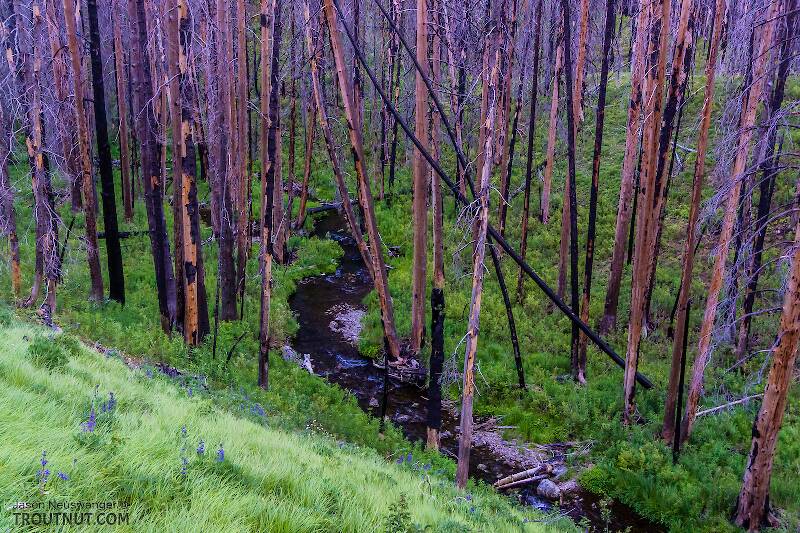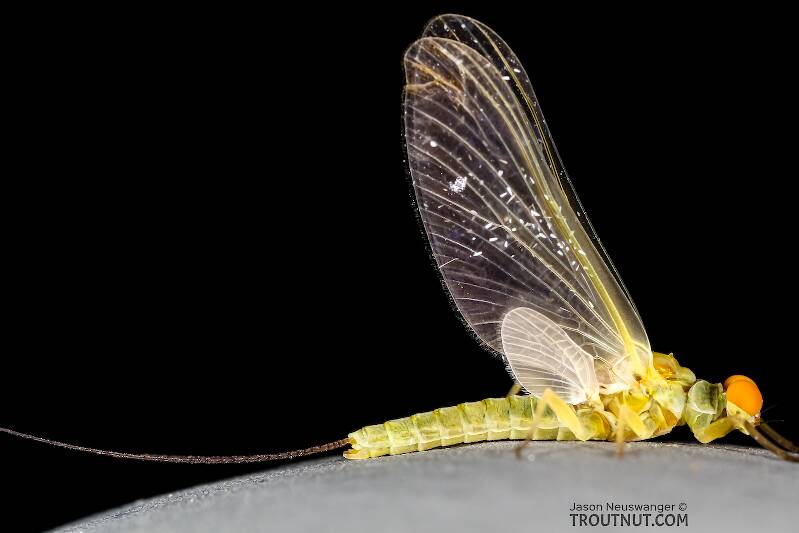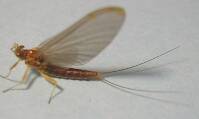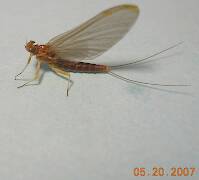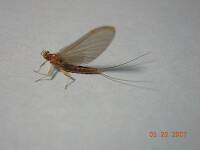
Hex Mayflies
Hexagenia limbata
The famous nocturnal Hex hatch of the Midwest (and a few other lucky locations) stirs to the surface mythically large brown trout that only touch streamers for the rest of the year.
Featured on the forum

I caught this tiny larva without a case, but it seems to key pretty clearly to to Glossosomatidae. From there, the lack of sclerites on the mesonotum points to either Glossosoma or Anagapetus. Although it's difficult to see in a 2D image from the microscope, it's pretty clear in the live 3D view that the pronotum is only excised about 1/3 of its length to accommodate the forecoxa, not 2/3, which points to Glossosoma at Couplet 5 of the Key to Genera of Glossosomatidae Larvae.

Troutnut is a project started in 2003 by salmonid ecologist Jason "Troutnut" Neuswanger to help anglers and
fly tyers unabashedly embrace the entomological side of the sport. Learn more about Troutnut or
support the project for an enhanced experience here.
Troutnut on Aug 17, 2020August 17th, 2020, 6:07 am EDT
It seems like most of the imitations I see in fly shops for PMDs, and dubbing mixes or other body materials designed to imitate PMDs, are a pale yellow color. I would just like to use this specimen to point out that in many cases (or in all the cases I've seen), most true PMDs (Ephemerella excrucians) are not yellow, but olive (with a bit of a gold tinge). I have some René Harrop PMD dubbing with the appropriate olive cast, but other than that I'm just seeing a lot of pale yellow more suited to eastern sulphur mayflies than excrucians.
The label PMD also applies to Ephemerella dorothea infrequens, but it seems they're also green as duns, unless I misidentified that specimen by associating an excrucians dun with nearby dorothea spinners.
The label PMD also applies to Ephemerella dorothea infrequens, but it seems they're also green as duns, unless I misidentified that specimen by associating an excrucians dun with nearby dorothea spinners.
Jason Neuswanger, Ph.D.
Troutnut and salmonid ecologist
Troutnut and salmonid ecologist
Partsman on Aug 17, 2020August 17th, 2020, 7:38 am EDT
Jason, that's just part of the confusion added to laymen such as myself. In her book Hatch Guide for the Upper Midwest, Ann Miller describes the Ephemerella dorothea Dun as pale yellow with white wings, maybe its the difference between western waters and Midwest waters. I get pretty easily confused with some of this, lately its been the Iso, what is the difference in the dark red almost burgundy color and the gray? Well it keeps busy and thinking for sure! Also, what do use for collection net? That picture looks like what I need, I seem to be more interested in what the fish are eating and why these days. Thanks for all you do here,
Mike.
Mike.
Troutnut on Aug 17, 2020August 17th, 2020, 8:16 am EDT
Ephemerella dorothea is tricky because it has two different subspecies, one of which is the small/late sulphur, or sometimes called pale evening dun, of the east/midwest (Ephemerella dorothea dorothea). That one is pale yellow. The western Ephemerella dorothea infrequens subspecies seems to have an olive cast (unless I misidentified it), but the other main western PMD (Ephemerella excrucians) is practically flat-out green, or at best olive with a golden cast. Not pale yellow.
The collection net was custom-sewn by my mom from some high-quality net material to fit a net frame I bought on Amazon with a lower-quality net bag, and that I made a grip for for with some rod-building material on top of the telescoping arm. It was really nice. Sadly I lost it on this trip because the piece-of-@#%#@ handle was constantly trying to fall apart in one way or another and finally succeeded. I was paranoid about it the whole time and compulsively checking on it, but sadly the one time it finally fell off was on a sweltering hot hike out of a spot, after which I was just happy to throw off my gear and turn on the AC... so I rushed through that and didn't notice the missing net until after the 5-hour drive to the next area of the trip.
I LOVED this net during the time I got to use it, as it came in really handy for catching bugs out of the air, sweeping through the grass to see what bugs were around, and even straining the water to see what was drifting on the surface. I'm thinking about trying to find a company to help manufacture something like this with components that won't fall apart, because every normal bug net I've found to buy online was either cheap garbage or too large (and with a fixed, non-telescoping handle) to portably carry while fly fishing. It seems like there might be a market for a high-quality, telescoping bug net you can carry on a magnetic release on the back of your fishing vest alongside your landing net.
The collection net was custom-sewn by my mom from some high-quality net material to fit a net frame I bought on Amazon with a lower-quality net bag, and that I made a grip for for with some rod-building material on top of the telescoping arm. It was really nice. Sadly I lost it on this trip because the piece-of-@#%#@ handle was constantly trying to fall apart in one way or another and finally succeeded. I was paranoid about it the whole time and compulsively checking on it, but sadly the one time it finally fell off was on a sweltering hot hike out of a spot, after which I was just happy to throw off my gear and turn on the AC... so I rushed through that and didn't notice the missing net until after the 5-hour drive to the next area of the trip.
I LOVED this net during the time I got to use it, as it came in really handy for catching bugs out of the air, sweeping through the grass to see what bugs were around, and even straining the water to see what was drifting on the surface. I'm thinking about trying to find a company to help manufacture something like this with components that won't fall apart, because every normal bug net I've found to buy online was either cheap garbage or too large (and with a fixed, non-telescoping handle) to portably carry while fly fishing. It seems like there might be a market for a high-quality, telescoping bug net you can carry on a magnetic release on the back of your fishing vest alongside your landing net.
Jason Neuswanger, Ph.D.
Troutnut and salmonid ecologist
Troutnut and salmonid ecologist
Partsman on Aug 18, 2020August 18th, 2020, 12:57 am EDT
Let me buy the first one!
Mike.
Mike.
Troutnut on Aug 18, 2020August 18th, 2020, 4:36 am EDT
It's good to know there's some interest! I've never done anything like this before--searching for a manufacturer to build some product that doesn't exist--but it might be worth figuring out how.
Jason Neuswanger, Ph.D.
Troutnut and salmonid ecologist
Troutnut and salmonid ecologist
Martinlf on Aug 20, 2020August 20th, 2020, 2:39 am EDT
Jason this is interesting. I tied up PMD's for the Missouri, basing my color scheme on Matt's samples and the advice and sample flies from fly shops in the area. Matt has fished the Missouri for many years. The dubbing he uses, and the dubbing for the flies sent to me by local shops was all pale yellow, with the slightest hint of olive in some. This may be, in part, due to the fact that most say duns are not effective on the Missouri; that the trout will eat emergers, but tend to ignore the duns. Perhaps the emergers are lighter and darken to a more olive color. I hope Matt chimes in here, and others who know the Missouri. I cancelled my trip, but hope to go next summer. I have a bunch of flies ready to fish.
"He spread them a yard and a half. 'And every one that got away is this big.'"
--Fred Chappell
--Fred Chappell
Martinlf on Aug 20, 2020August 20th, 2020, 2:46 am EDT
I did a little poking around and found this post from Kurt a while back: " The western subspecies dorothea infrequens has incredible variation with many forms that paradoxically look much closer to their sister subspecies back East than their own. I've seen 'em from a peachy orange size 12 to a greenish yellow size 16, with all kinds of differences in between. For example, a variety that hatches on the Deschutes in OR is virtually indistinguishable in size, form and color from the pale yellowish ones that hatch in the limestone country of PA. It looks much different from the larger orange jobs hatching in the next river over. On Hat Creek (and most Sierra Watersheds) in CA they are large and peachy. On Fall River right around the corner, they are smaller and greenish. Then there's the confusion caused by the virtually identical (and equally variable) excrucians (prev. inermis) thrown into the mix. The most brilliant entos in the world have trouble telling them all apart. There is much left to do with this group of critters."
"He spread them a yard and a half. 'And every one that got away is this big.'"
--Fred Chappell
--Fred Chappell
Troutnut on Aug 20, 2020August 20th, 2020, 5:36 am EDT
I'd be interested to see some of the larger, peachy orange specimens he was talking about and key out nymphs or male spinners. I imagine there is some regional variation, but I've seen the green ones now across several streams in that ID/MT/WY corner and no yellow or orange ones yet. I would make sure to have a few duns in your box... the trout on the Henry's Fork were definitely eating them when I was there.
What's your favorite fly style for the emergers? For duns, I've been having a lot of success lately with what's basically a "no-hackle" but with a wing of hare's foot dyed to a natural dun color, which floats well and stays visible.
What's your favorite fly style for the emergers? For duns, I've been having a lot of success lately with what's basically a "no-hackle" but with a wing of hare's foot dyed to a natural dun color, which floats well and stays visible.
Jason Neuswanger, Ph.D.
Troutnut and salmonid ecologist
Troutnut and salmonid ecologist
Martinlf on Aug 20, 2020August 20th, 2020, 11:40 am EDT
Jason, when I fished the Henry's Fork years ago my guide gave me a fly that I often use on tough fish. It's like a klinkhamer, with a dark abdomen the color of the nymph. I use a biot or thread to imitate the color of the nymph, with a tail of wood duck, cdl, and/or zelon. The thorax is much like a thorax style dry, with burned or cut hen neck wings, and sparse hackle cut flat on the bottom. If fish aren't so picky, I'll use the same style, but with a parachute wing, like the klinkhamer. Or a snowshoe wing. All work just fine for me most of the time. A Montana shop sent me a fly called a Film Critic, a Quigley pattern that they recommend for the Missouri, and I've been told that a fly patterned on the Smoke Jumper fly, but with a dun/emerger colored thorax can be very good on Missouri PMDs. But my go to mayfly emerger is the klinkhamer style, with the parachute wing, and a thorax the color of the emerging dun.
"He spread them a yard and a half. 'And every one that got away is this big.'"
--Fred Chappell
--Fred Chappell
Troutnut on Aug 20, 2020August 20th, 2020, 11:58 am EDT
Thanks. Those flies all sound interesting.
Have you tried using any of the semi-translucent Body Quill tying materials (Veevus, Hend's) for the nymph bodies on the emergers? I've becoming addicted to that stuff and use it now in probably more than half the flies I tie. It's so versatile... you can use it like thread in a bobbin to tie in other parts, or form a body entirely of body quill, or put a thread base underneath and overlay it with body quill to get all kinds of different color combinations. I normally do a very thin coat of UV resin to strengthen it, but I've heard it works fine without that and I'm trying some flies tied that way on my next trip.
Have you tried using any of the semi-translucent Body Quill tying materials (Veevus, Hend's) for the nymph bodies on the emergers? I've becoming addicted to that stuff and use it now in probably more than half the flies I tie. It's so versatile... you can use it like thread in a bobbin to tie in other parts, or form a body entirely of body quill, or put a thread base underneath and overlay it with body quill to get all kinds of different color combinations. I normally do a very thin coat of UV resin to strengthen it, but I've heard it works fine without that and I'm trying some flies tied that way on my next trip.
Jason Neuswanger, Ph.D.
Troutnut and salmonid ecologist
Troutnut and salmonid ecologist
Martinlf on Aug 21, 2020August 21st, 2020, 5:20 am EDT
I haven't tried Hends or Veevus quills, but it sounds promising. I use Veevus thread more and more these days. I have been using porcupine quills/guard hairs for some mayfly bodies. We encountered a great light cahill hatch on a new stream this spring, and I had some snowshoe winged cahills I'd bought from Penns Creek Anglers, my favorite shop on the creek. (I buy Bruce's flies primarily to see new patterns and to support the shop.) The fish demolished them in time, so I've been tying more, some with white deerhair, some with snowshoe comparadun style wings. I've used a variety of body materials, including snowshoe underfur, and cream white porcupine quills. Allen Landheer, a local tyer uses porcupine for mayfly abdomens, and highly recommends the quills. He coats the abdomens with thin Solarez, applied very sparingly, so I've done that. The bodies look very realistic, well segmented--and according to Al, the quills are tough and buoyant. I've tied some rusty spinners with them, and I'm going to tie some sulphurs with dyed quills this winter, and perhaps some olives. After trying my typical emergers, etc. I used a quill bodied sulphur comparadun on the East Branch of the Delaware a few years back, and it seemed the only thing fish would take--though I'm well aware of what scientists call superstitious behavior. But the experience sold me. It's been hard to find good quills; Al takes them from road killed porcupines, but I haven't tried that . . . yet. I have two packs I bought, and I've dyed up about half of them in yellow, orange, rusty brown, and olive, keeping some natural white, but my source seems to have dried up.
"He spread them a yard and a half. 'And every one that got away is this big.'"
--Fred Chappell
--Fred Chappell
Wbranch on Aug 22, 2020August 22nd, 2020, 12:39 pm EDT
Jason wrote;
Sure, I've fished many Montana spring creeks and tail waters where the PMD is THE FLY dry fly guys wait for all year long. I've known since the late 1960's that the PMD adult has a light greenish abdomen and thorax, The wings are a light gray but the leading edge often is light yellow. Basically every PMD cripple and emerger and dun is tied with a light yellow body which might he appropriate for the eastern Sulfur emergence but surely not for the western PMD.
If anyone has a copy of Swisher & Richards "Selective Trout" their color plate of the PMD are true to color.
I would just like to use this specimen to point out that in many cases (or in all the cases I've seen), most true PMDs (Ephemerella excrucians) are not yellow, but olive (with a bit of a gold tinge).
Sure, I've fished many Montana spring creeks and tail waters where the PMD is THE FLY dry fly guys wait for all year long. I've known since the late 1960's that the PMD adult has a light greenish abdomen and thorax, The wings are a light gray but the leading edge often is light yellow. Basically every PMD cripple and emerger and dun is tied with a light yellow body which might he appropriate for the eastern Sulfur emergence but surely not for the western PMD.
If anyone has a copy of Swisher & Richards "Selective Trout" their color plate of the PMD are true to color.
Catskill fly fisher for fifty-five years.
TNEAL on Aug 24, 2020August 24th, 2020, 3:28 am EDT
Some Years back I tied 4 dozen #18 Roberts Drakes for a friend who was going out West specifically to fish PMDs. He told me it was by far the best pattern they had for the hatch; that the fish took it on the first cast every time. Roberts Drakes are tied with light tan deer hair for the body and ribbed with yellow thread; they are an emerger pattern.
Wiflyfisher on Aug 28, 2020August 28th, 2020, 11:53 pm EDT
Jason,
I just back a week ago from 2 weeks out West. I fished the Fork for 4 days. For most of us who frequently fish the Fork we know the PMDs are more olive than the Midwest or Eastern E. dorotheas.
Below is a crappy photo of a PMD just after emerging from the Fork. It is difficult to get the insects to stop moving while on the river.

Below is a E. dorothea emerger in my seine from the Nam this past May.

One of the many things I love about out West...bank feeders..

Side note: The PMDs (guessing) I saw hatching on Soda Butte did not look as olive as the ones on the Fork.
I just back a week ago from 2 weeks out West. I fished the Fork for 4 days. For most of us who frequently fish the Fork we know the PMDs are more olive than the Midwest or Eastern E. dorotheas.
Below is a crappy photo of a PMD just after emerging from the Fork. It is difficult to get the insects to stop moving while on the river.

Below is a E. dorothea emerger in my seine from the Nam this past May.

One of the many things I love about out West...bank feeders..

Side note: The PMDs (guessing) I saw hatching on Soda Butte did not look as olive as the ones on the Fork.
John S.
https://WiFlyFisher.com
https://WiFlyFisher.com
Quick Reply
Related Discussions
Topic
Replies
Last Reply
0
Jun 29, 2020
by Wiflyfisher
by Wiflyfisher
2
Nov 4, 2012
by Aszat
by Aszat
Re: So is Ep Infrequens now known as Ep Dorothea?
In the Mayfly Species Ephemerella dorothea infrequens by Wbranch
In the Mayfly Species Ephemerella dorothea infrequens by Wbranch
20
Jul 1, 2014
by Crepuscular
by Crepuscular

